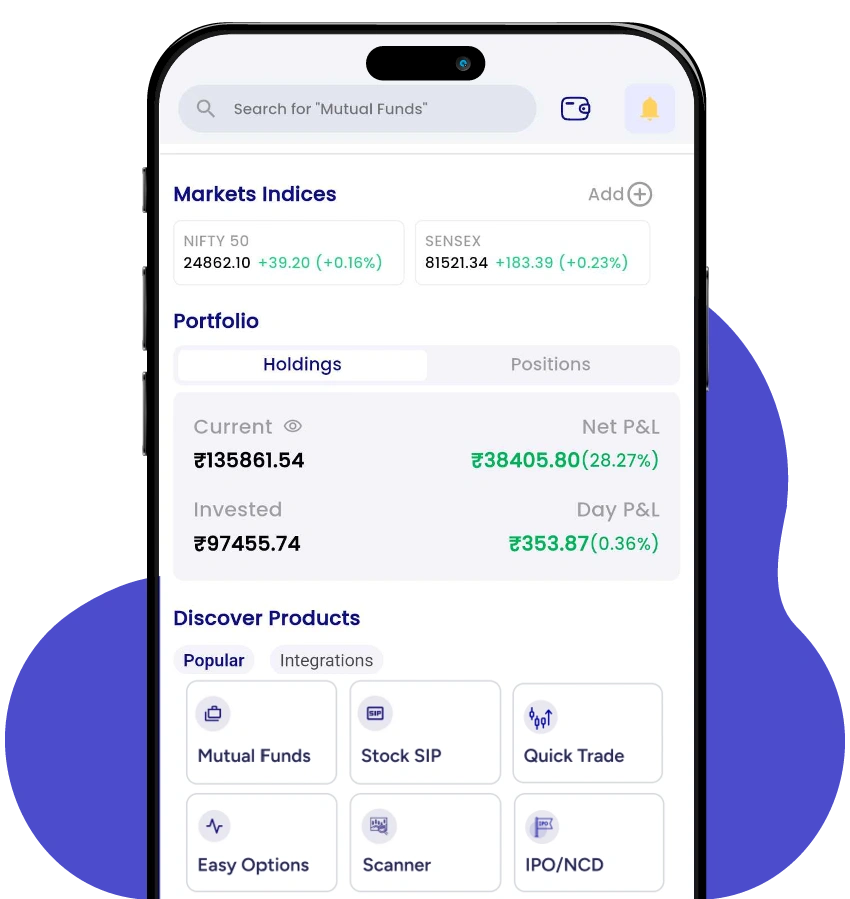What is IPO?
- 9th October 2025
- 12:30 AM
- 11 min read
An initial public offering (IPO) is the first step for a company to get listed on the stock exchange. Big companies like Zomato, Nykaa, and Urban Company started their stock market journey with the help of an IPO.
The popularity of IPOs in India has been continuously increasing, with 108 IPO deals raising USD 4.6 billion in the first half of 2025.
This blog highlights the IPO full form, its different types, benefits, and limitations.
What is an IPO in the Stock Market?
An IPO is a process through which a private company sells its shares to the public to raise capital from them. With this new capital from public investors, companies facilitate easy trading of their existing assets to monetise investments of existing shareholders.
These funds are raised from different categories of investors, such as institutional investors, high-net-worth individuals (HNWIs), and the general public. An IPO not only helps private companies to expand their business but also allows early investors to gain returns.
Moreover, going public also increases a company’s credibility, which helps it to attract more media attention and other opportunities.
Different Types of IPO
After knowing the IPO meaning, you must understand the different types of IPOs available in the Indian market. There are two common types of IPOs in India:
-
Fixed Price Issue
In a fixed price issue, companies follow a straightforward process to set a predetermined issue price for shares by underwriting and analysing their liabilities, assets, and other financial data. Companies determine a fixed price of each share in this process, which remains constant throughout the IPO procedure.
Since investors become aware of the stock price during the public offering, they have to pay the total share price in the application. Investors appreciate the fixed price issue because of its transparency.
-
Book Building Issue
In a book building issue process, companies take a dynamic approach in determining the share prices by offering a 20% price band on them. In this price range, investors have to bid for the shares. An upper limit of the price range is called ‘cap price’, and a lower limit is known as ‘floor price’.
Investors submit bids within the price range and indicate the quantity they want to purchase and the price they are willing to pay. This procedure offers flexibility and reflects the market demand.
How Does an IPO Work?
A company raises its capital from public investors by issuing shares with an IPO. Here is a detailed breakdown of how it works:
-
Recruitment of an Investment Bank
Companies identify an investment bank or underwriters to start the IPO process. The team evaluates a company’s financials and signs the underwriting agreement with the amount details. These experts act as a bridge between potential investors and the company.
-
Preparation
Companies adhere to the IPO guidelines of the Securities and Exchange Board of India (SEBI). They create a comprehensive statement and a Draft Red Herring Prospectus (DRHP). With these documents, investors get potential insights about a company’s financials and operations.
-
Approval and Verification
Once companies make the registration statement and DHRP ready, they are submitted to the SEBI for approval. The SEBI verifies the information to ensure transparency and provides a green light to the company to go ahead.
-
Stock Exchange Listing
After getting SEBI’s approval, a company can apply to list its IPO on any one stock exchange from the National Stock Exchange (NSE) and the Bombay Stock Exchange (BSE).
-
Roadshow
Along with underwriters, a company conducts a roadshow and takes marketing initiatives to promote the IPO to potential investors. The marketing initiatives include advertisements and an investor presentation to promote the growth potential of the company.
-
Price Determination
The offering price determination of the shares is a crucial task for a company. This marks the company’s official entry into public trading. This allows investors to trade its shares in the stock market.
-
Initiating the Bidding Process
Investors can start placing bids in a specified price range once the price has been determined. In this phase, investors can adjust their bids before the final allocation.
-
Allocation
Once the bidding process ends, companies allocate shares to successful IPO participants along with underwriters. There will be partial allotments to ensure fair distribution in case of partial allotments.
If you want to apply for IPOs and avail all of these benefits, open a Demat account with PL Capital Group – Prabhudas Lilladher now! Once you have a Demat account, PL allows you to apply for an IPO with just 5 steps:
- Log in to your PL account using your credentials.
- Choose the IPO you are willing to invest in and select the bid.
- Enter the number of lots and your price.
- Enter your UPI ID and click on ‘Submit’.
- Complete the transaction through your UPI app by accepting the mandate request.
Benefits of an IPO
-
Access to Capital
Investors can access higher capital as the private companies receive cash flow from an IPO and achieve growth. Additionally, it allows the general public to become early investors and benefit from the company’s growth trajectory.
-
Increased Recognition
Publicly traded companies get more recognition than private companies. In addition, public companies get more media coverage in the financial sector.
-
Liquidity
A publicly traded company has better liquidity and marketability of its shares. After becoming public, its investors can trade its shares in the stock market.
-
Discount in Early Entry
An IPO allows you to invest in a company at an early stage. This gives you an opportunity to buy shares at a lower rate than their post-IPO market price. This early entry offers you an advantage for higher returns in the long run.
-
Diversification
IPOs facilitate portfolio diversification with a risk management approach. Through an IPO, investors can invest their funds in new companies beyond their existing holdings. However, diversification can reduce the risk related to investing in a single company or industry. This can eventually improve your return potential.
Limitations of an IPO
-
Volatilities and Uncertainties
While IPOs provide a chance to invest in innovative and fast-growing companies, they are inherently volatile and carry significant risk. Without dependable performance and financial data, accurately evaluating the company’s full potential becomes challenging, increasing the likelihood of misjudgment.
-
Limited Information
Investors have to deal with limited information about new companies while participating in an IPO. The reason is that private companies do not disclose the same level of financial details as publicly traded ones.
This limited information can make it challenging for investors to analyse a company’s fundamentals and competitive landscape.
-
Higher Costs
For beginners, IPOs can be quite expensive. The IPO transaction process requires an investment of higher capital in an underwriter, an investment bank, and an advertiser to run everything smoothly.
Eligibility Criteria to Invest in an IPO
As you have understood the benefits and limitations of an IPO, you have to understand the eligibility criteria before applying for it:
- You must hold a PAN card issued by the Income Tax Department of India to invest in an IPO.
- You must have a valid Demat account.
- Usually, investors do not have to open a trading account for an IPO. However, if he or she wants to sell the shares after getting listed, they have to open one. With PL, you can open both a Demat and a trading account without any hassle.
Important Terminologies Related to IPO
| Terms | Meaning |
| Underwriter | Underwriters are third parties, such as a financial institution, banker, merchant banker, or broker. It helps companies in underwriting their stocks. These individuals also commit that they will subscribe to the balance shares if investors do not choose the stocks offered at IPO. |
| Issuer | An issuer can be the firm that is willing to issue shares for the first time through an IPO in the secondary market to raise capital. |
| Fixed Price IPO | Fixed Price IPO is known as the issue price that some companies set to sell their shares. |
| Price Band | A price band is a range in which investors place bids in an IPO. An issuer sets this range, which guides the buyers. This range is mentioned in an offer document. |
| Under Subscription | When the number of securities applied for is lower than the number of shares made available to the public, an under-subscription takes place. |
| Draft Red Herring Prospectus (DRHP) | The DRHP is the document filed by a company to let the public know about their IPO listings once the SEBI has made the approval. |
| Green Shoe Option | Green shoe is an overallotment option, which permits the underwriter to sell additional shares than initially planned by the company. This option stabilises the stock price if the demand exceeds the expected. |
| Oversubscription | Oversubscription happens if the number of shares offered to the public is comparatively lower than the number of shares applied for. |
| Book Building | Book building is a process in which a merchant banker determines the offering price of an IPO. |
| Flipping | Flipping means reselling an IPO stock in the first few days to earn quick gains. |
Things to Consider While Investing in IPOs
Since IPOs are highly volatile and are overvalued, you must consider the factors below before applying for one:
-
Research
Always study the company background and analyse its financials before applying for its IPO. It is crucial to understand the growth potential of a company.
-
Lock-in Period
Check the lock-in period of an IPO, since this can limit your ability to trade IPO shares immediately after the initial investment.
-
Investment Strategy
Plan an investing strategy before applying for an IPO. Determining your risk tolerance and financial goals is crucial for this.
Final Thought
Understanding the IPO full form and how it works can benefit you with high liquidity, diversification, and provide access to capital. However, it also has a lock-in period and is costly. Investors must hold a PAN card and have a Demat account to apply for an IPO.
Download the PL Capital to stay up to date about the latest IPOs, market trends, and investment opportunities. Additionally, you can apply for an IPO with PL in just 5 steps.
Frequently Asked Questions
1. Is an IPO better than stock?
Neither stock nor IPO is better than the other, since it completely depends on your investment goals and risk tolerance.
2. Is there no risk associated with an IPO?
No, IPOs carry significant risks like over-valuation issues, high volatility, limited company information, and no assurance of share allotment.
3. Can an average person purchase an IPO?
Yes, anyone can invest in an IPO, but with specific eligibility criteria. Individual investors, HNWIs, institutional investors, and other people can purchase an IPO.
4. After the IPO, can I sell my stock?
Yes, you can sell a stock immediately after an IPO, after 10 AM. However, investors like promoters and anchor investors have a lock-in period on the listing day, in which they cannot sell the shares.
5. When is the ideal time to make an IPO investment?
The ideal time to invest in an IPO depends on a company’s financial health and growth potential.
6. How is allocation for an IPO determined?
An IPO allocation is determined by the demand and supply for shares, investor categories, lot size, and other factors.





